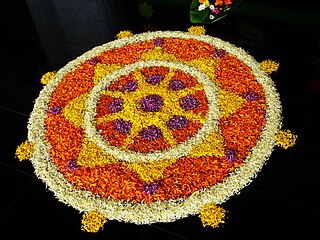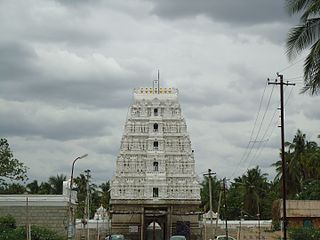
Onam is an annual Indian harvest festival celebrated predominantly by the people of Kerala. A major annual event for Keralites, it is the official festival of the state and includes a spectrum of cultural events.
"God's Own Country" is a phrase meaning an area, region or place supposedly favoured by God.
Padmanabha is an epithet of the Hindu deity Vishnu. It may refer to:
Marthandam is a major trade centre in Kuzhithurai municipality across National Highway in the Kanyakumari district of Tamil Nadu, India. Formerly known as Thoduvetty, it was a portion of Kanyakumari district which was added to the state of Tamil Nadu on 1 November 1956.

Padmanabhapuram Palace, also known as Kalkulam Palace, is a Travancore era palace located in Padmanabhapuram in the Kanyakumari district of the Indian state of Tamil Nadu. The palace is owned, controlled and maintained by the government of the neighbouring state of Kerala. Padmanabhapuram is the former capital city of the erstwhile Hindu kingdom of Travancore. It is around 20 km from Nagercoil, 39 km from Kanyakumari town and 52 km from Thiruvananthapuram in Kerala. The palace is complex inside with an old granite fortress around four kilometers long. The palace is located at the foot of the Veli Hills, which forms a part of the Western Ghats. The river Valli flows nearby.

Thiruvananthapuram District, is the southernmost district in the Indian state of Kerala. The district was created in 1949, with its headquarters in the city of Thiruvananthapuram, which is also Kerala's administrative centre. The present district was created in 1956 by separating the four southernmost Taluks of the erstwhile district to form Kanyakumari district. The city of Thiruvananthapuram is also known as the Information technology capital of the State, since it is home to the first and largest IT park in India, Technopark, established in 1990. The district is home to more than 9% of total population of the state.

The Adikesava Perumal Temple is a Hindu temple located in Thiruvattar, Kanyakumari district, Tamil Nadu, India and is one of the 108 Divya desams, the holy sites of Hindu Vaishnavism according to existing Tamil hymns from the seventh and eighth centuries C.E. The temple is one of the historic thirteen Divya Deshams of Malai Nadu. The temple is a picturesque setting surrounded on three sides by rivers namely, It was the Rajya Temple and Bharadevatha shrine of Erstwhile Travancore. After state reorganisation, the temple handed over to Tamilnadu H&RCE Dept. The presiding Vishnu in the form of Ananthapadmabhan/Adikeshavaperumal is believed to be older than Padmanabhaswamy Temple in Thiruvananthapuram. Since Vishnu resides here in a reclining position, and is surrounded by rivers, the temple is called as "The Srirangam of Chera Kingdom".
P. Subramaniam was an Indian film producer, film director, distributor, theatre owner, and mayor. He is the founder of Merryland Studio, the second film studio in Kerala.

The Kizhakke Kotta, commonly known as East Fort, is a busy commercial street located at the heart of the central business district of Thiruvananthapuram city the capital of Kerala. East Fort is known as the heart of the city as it is located in the center. Since Trivandrum was known as Travancore, East Fort was a commercial suburb with the presence of the Padmanabhaswamy Temple since 1900. East Fort also stands up as the second largest shopping area after the posh shopping area of Pulimoodu.

Thrikkakara Vamanamoorthy Temple is one of the few Hindu temples in India dedicated to Lord Vamana/Vishnu. It is situated in Thrikkakara, Kochi in the state of Kerala, India. Located around 10 km north-east of the city center between Thrissur-Ernakulam highway, Seaport-Airport Road, Cochin University of Science and Technology and Model Engineering College, it is a centre of celebrations and a place of origin for the popular Onam festival. The temple is around two millennia old and is also listed as one of the 108 Divya Desams.
Vilwamangalam Swamiyar or Vilwamangalathu Swamiyar is the name of more than one saint who lived in India. The first Vilwamangalam, a Swamiyar belonging to Naduvil Madhom, who lived in the 8th century. The spot of his samadhi is to the west of Sree Padmanabhaswamy Temple. The second saint who belonged to Thekke Madhom, Thrissur lived during the middle of 14th century. He was an ardent devotee of Lord Guruvayoorappan. Both the Swamiyars were native to Malai Nadu. The first Swamiyar was born in Sukapuram Gramam in Kerala. The second Swamiyar was renowned all over India. Bengalis believe that he was born in Bengal while Odias believe in Odisha, though tradition in Kerala implies that he belonged to Panniyoor village. "Sreekrishna Karnamritham" is his devotional masterpiece, written under an unspecified name "Leelasukan". The second Vilwamangalam is closely associated with several famous temples in Kerala such as Thiruvarppu, and Cherthala Kaarthiaayani.

Kummattikali or Kummatti Kali is the famous colorful mask-dance of Kerala, prevalent in Thrissur District, Palakkad District and parts of South Malabar. During the festival of Onam, Kummattikali performers move from house to house collecting small gifts and entertaining people. Kummatti dances are rampant in the Thrissur district during Onam. Pristine or original form of Kummattikali can be seen in the Bhadrakali temple in Palakkad district. Kerala
Naduvil Madhom is one of the ancient South Indian madhoms that propagate Advaita or Non dualism. It is located at Thrissur in Kerala. The history of the Madhom can be traced to 9th century AD. So the four disciples of Sankara founded four madhoms nearby. Sureśvara founded Naduvil Madhom, Padmapada Thekke Madhom, Hastamalaka Idayil Madhom, and Totakacharya Vadakke Madhom. Sri Suresvaracharya appointed Vilvamangalathu Swamiyar as the first Mooppil Swamiyar (head) of Naduvil Madhom.

Sri Anantha Padmanabha Swamy Temple is a Hindu temple located in Ananthagiri, Vikarabad district in Telangana, India. It is temple of Lord Vishnu.
The Mithrananthapuram Trimurti Temple is a Hindu temple complex in Thiruvananthapuram, Kerala, India. It is a temple in where devotees get to offer worship to all the three Trimurti deities, namely,. The Temple is located on the western side of Padmanabhaswamy temple in Thiruvananthapuram.

Karthyayani Devi Temple, Cherthala is a famous Hindu temple located at Cherthala. Iratti and Thadi are the famous vazhipadu, Cherthala pooram is the second famous pooram in Kerala. Kalabham, in familywise, can be held on there, kalabham is a famous vazhipadu.

Ananthagiri Hills is located in Vikarabad district, Telangana, India. The water flows from these hills to Osman Sagar, also known as Gandipet lake, and Himayathsagar.

Aswathy Thirunal Gowri Lakshmi Bayi of the Travancore Royal Family is an Indian writer from Kerala. She has ten books to her credit.
Sreevaraham Lakshmi Varaha Temple, locally known as Sreevaraham Temple, is situated at Sreevaraham, in Thiruvananthapuram, very near to the famous Sree Padmanabhaswamy Temple. The principal deity of this temple is Varahamurthy, the third incarnation of Lord Vishnu. This Hindu temple is administered by the Travancore Devaswom Board.

Sri Venugopalaswamy Temple is a Hindu-Vaishnavite temple situated at Karvetinagaram in, Chittoor District of Andhra Pradesh state, India. The Temple is dedicated to Lord Krishna, ninth incarnation of Vishnu's Dasavatharam, who is referred to as Venugopala. It is situated at a distance of 58 km from Tirupati and 12 km from Puttur.














